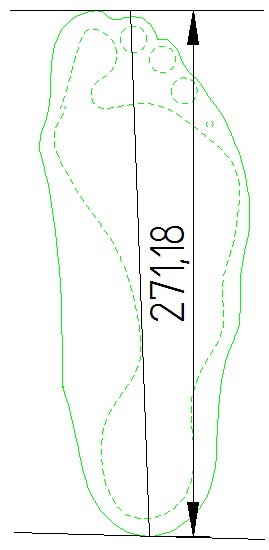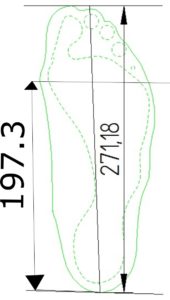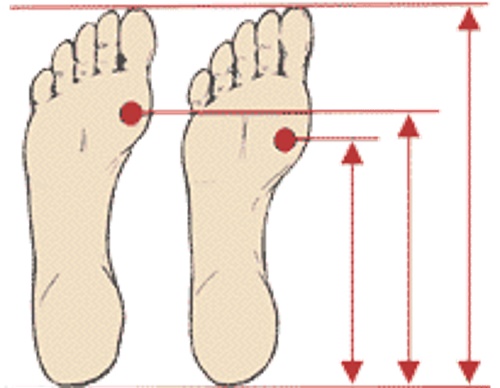Without doing do a proper foot measurement it’s not possible to detect an appropriate shoe size.
Foot length and -width needs to be measured at least two, better three times on different times of the day. This is helping you to observe your feet closer and will gives you more accurate information about your foot length and width, because the metrics for the foot can change up to one shoe size up form morning to evening.
In the previous post “Why my shoes don’t fit? (Shoe width)“, we have discussed shoe sizes, – width and that we require conversion tables to detect our shoe size and -width.
Shoe size conversion tables are all about standard last length, the foot length is only secondary. We need to do our foot measurement and follow the conversion tables. This is not really precise enough for me, I would even say: it’s wrong!
I have already explained, that different types and styles of footwear require different last length – a sandal has a different last length compare to a pointed-toe court shoe. On the other hand, it wouldn’t be practical for the shoe industry to create for every shoe type a conversion table – there would be too many. As long there is no other and more customer friendly metric system in place, like some kind of system which I have suggested in the previous articles, we are left with no other choice than to continue and using standard-last-length conversion tables. But I like to show you now a different method of foot measurement, instead of the traditional method of measuring your foot length from heel to toe.
It’s not difficult at all, we only need to understand, that shoe lasts are designed in a particular system and last length of the shoe last is only one part of it. There are other measurements as well, which are parametric calculated and this leads us to other measurement points of the shoe last, which has to present your feet. We have discussed this in the third part of “Why my shoes don’t fit? Part 3)” and now we are making use of it. We begin with our foot measurement:
Here you see again a right foot, which you have seen already in the previous posts.
The length of the foot is 271 mm long.
We always do the foot measurement from the center of the heel, through the second toe up to the parallel line of the highest point of the foot.
In this case, it’s the length of the big toe, which presents the highest point of the foot, but in many cases, it’s the second toe which is the longest part of the foot.
Every foot is like a fingerprint and almost never both the feet are identical and feet are changing with the age – also because of wrong fitted footwear!
What is very important, is the length from the heel center to the inside joint. Here it shows a length of 197 mm.
Now, why is suddenly our foot length important? Because the joint positions from the shoe last and the joints from the foot must to have the same positions. The width of the joint line depends on width fitting of the last and we have discussed this in the previous post, but the positions of the joints on the shoe last are fixed for each shoe size following the standard last length of the conversion tables.
The formula for the joint length of a shoe last, from heel to the inside joint, is 2/3 of the length for a standard last.
In our first picture above, we remember that our foot length was 271 mm and if we look into our conversion table, we would assume that our shoe size should be a UK 9 1/2 or US 10 size.
| US Sizes | Euro Sizes | UK Sizes | Inches | Foot Length |
| Sizes | Sizes | Sizes | in cm | |
| 9.5 | 42-43 | 9 | 10.4375″ | 26.7 |
| 10 | 43 | 9.5 | 10.5625″ | 27 |
| 10.5 | 43-44 | 10 | 10.75″ | 27.3 |
| 11 | 44 | 10.5 | 10.9375″ | 27.9 |
But now let’s come back to the 2/3 length of our shoe last and compare this with our foot length of 197 mm. We need to remember that the shoe last and the foot length are not identical and that’s why need two different systems to locate the joint position. To make it easy we have prepared a new conversion table for the heel to joint length.
If we look in our conversation table above, we are getting a new result:
UK size “10”
or US size “10 1/2”
This is what I call a “calculated shoe-size”. It’s important to understand, that the full shoe length is not really important for us. If your shoe is a little bit longer, in this example 4.23 mm for 1/2 size up, it doesn’t matter at all. Look at the above image again. What are 4 mm extra, if you have 12, 16 or 20 mm space in the toe part of your shoe? Now you might have 20 mm and that’s still not a problem at all, but the most important points of the foot, the joints are in a perfect position and at the joints a few millimeters up and down are making a very big difference for your shoe fitting.
You might have doubts because simply choosing a bigger shoe size can’t really solving your problem? It’s not like that, if we do our foot measurement and calculate our appropriate shoe size, the result could be as well, that our shoe size is may be one size smaller or it stays unchanged. The main reason for the variations is, that the toes could be shorter or longer than the average norm and in our case the toes are shorter (see image below).
Still there is more to come in the final part-shoe-size-conversion of the series. You can also download the free ebook shoe guide with feet measurement instructions.
Andre Gerdes ( the foot-measurement follower )




Well, that explains a lot. I typically wear a women’s US size 9.5 or 10, but my heel to joint length is closest to a 10.5. I guess that’s why I find open-backed shoes most comfortable…my joint finds the right spot and my heel ends up further back. I’m really enjoying this series, thank you.